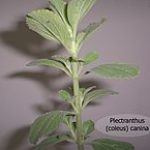Whether you are dealing with your own cats or attempting to keep your neighbours’ cats or stray cats out of your garden space, you are sure to have a bit of a struggle on your hands. Cats are clever and determined, so methods that might work with dogs (e.g. shouting, spraying with water or just saying NO!) will have limited or negligible effect.
When deterring cats, you need to use methods that will stay in place and be effective even when you are not around. In this article, I will introduce several plants that have cat-repelling and cat-attracting properties. I will also offer advice to help you deflect and redirect unwanted felines in your garden.
4 Best Types Of Plants to Deter Cats
Here are four types of plants that may be helpful in keeping cats away from off-limits areas of your garden.
 1. Scaredy Cat Plant (Coleus canina) is an attractive annual bedding plant that may deter both cats and dogs. The plant grows about two feet high and has good-looking, dark green foliage and pretty purple or blue flowers. This is a good border plant that can make a nice, low hedge around your garden space to help prevent intrusion by cats and dogs. When the animals run through the hedge, the leaves emit an odour which they find repellent
1. Scaredy Cat Plant (Coleus canina) is an attractive annual bedding plant that may deter both cats and dogs. The plant grows about two feet high and has good-looking, dark green foliage and pretty purple or blue flowers. This is a good border plant that can make a nice, low hedge around your garden space to help prevent intrusion by cats and dogs. When the animals run through the hedge, the leaves emit an odour which they find repellent
2. Rue (Ruta graveolens) is a shrub that grows to be about two or three feet high.  Its leaves are an attractive shade of blue/green, and it gives off an odor that cats don’t like. Planted as a low hedge around your yard, it may make a fairly effective barrier. Additionally, leaves can be gathered, dried and ground to sprinkle over areas (both indoors and outdoors) to keep cats away. Be advised that you should wear garden gloves when you handle rue plants as contact with its essential oils can cause blistering of the skin. This plant is somewhat toxic, and ingestion can cause vomiting, confusion and even seizures in people and animals.
Its leaves are an attractive shade of blue/green, and it gives off an odor that cats don’t like. Planted as a low hedge around your yard, it may make a fairly effective barrier. Additionally, leaves can be gathered, dried and ground to sprinkle over areas (both indoors and outdoors) to keep cats away. Be advised that you should wear garden gloves when you handle rue plants as contact with its essential oils can cause blistering of the skin. This plant is somewhat toxic, and ingestion can cause vomiting, confusion and even seizures in people and animals.
3. Strongly scented herbs may also be repellent to cats. A border or herb garden containing citronella grass, lemongrass, scented geraniums and lavender adds a pretty touch to your landscaping. While you will surely enjoy the scents, cats will not. Incidentally, quite a few insect pests are also repelled by the presence of these plants, so interspersing them throughout your yard and garden can be very helpful in a wide variety of ways.
4. Brambles and thorny plants can be a deterrent to dogs and cats, but this is a hit-and-miss business because cats are able to slip through very narrow spaces easily and may be able to go between thorny branches without touching them. Furthermore, bramble bushes that produce berries will attract birds, and hence, cats.
6 Non-Plant Cat Deterrents
In addition to adding plants that deter cats to your garden or around your house, there are a number of natural substances that may discourage cats.
1. Brew some repellent herbal tea. You can use your scented herbs to make strong smelling teas to spray about your home and garden.
2. Use essential oils. If you haven’t planted herbs, purchase essential oils (e.g. lemongrass, eucalyptus, lavender, tea tree, etc.) to mix up natural sprays which may deter cats and may also help keep unwanted insect pests away.
3. Make a cayenne and rue spray. Another cat and insect repelling concoction can be made by brewing up a decoction of rue and cayenne pepper to spray onto plants around your home and garden. Be very careful when brewing and handling this mixture as inhaling the steam or getting the liquid on your skin or into your eyes could result in injury.
4. Make good use of citrus peels! Chop up orange, grapefruit, lemon and lime peels and scatter them on the ground around plants you wish to protect from cats. The strong scent of the citrus oils is just as unpleasant to cats as it is pleasant to humans.
5. Mulch! To keep cats from digging in soft soil, mulch heavily around your plants with coarse bark.
Cats do not like to dig in bark and will probably leave plants surrounded by it alone. Mulching with pine cones or pine needles is also effective.
6. There are also a few commercial products / cat scarers you can purchase which may help keep cats away. Among them are:
- Predator urine can be sprayed around off-limits areas.
- Motion activated mechanical devices spray water or emit light and/or sound to frighten cats.
- Stubbly mats have soft points that will not harm cats but are uncomfortable to their paws.
Redirect Cats With Plants & Environmental Adjustments
In addition to deflecting cats from off-limits areas, you may find it helpful to establish a cat-friendly space in your garden to redirect cats. If your cat has an attractive space to dig, sun and enjoy safe plants, he or she will be less likely to bother your garden space. Having his or her own comfortable outdoor space will help lure your cat away from out-of-bounds garden areas.
Set up an area with a good, natural scratching post, a plot of sand, a patch of grass, a place in the sun, a hiding space and a pot of catnip. Don’t plant catnip directly in the soil. It is better to plant it in several pots and switch them out periodically because your cat will roll in and eat the catnip.
Keep your bird baths and bird feeders away from plants you wish to protect. You may want to place then nearer to your cat garden so that your pet can enjoy watching the birds. Just be sure to place them high enough that your cat cannot reach them and scare or harm the birds!
Which Solution Is Best?
There is no single solution to keeping cats out of your garden space. A smart combination of plants that deflect cats, along with redirection and aversive measures is your best bet for protecting plants from cat damage. Remember that cats are smart and curious, so you may need to change your tactics from time-to-time to be effective.








Thanks love my cats but my indoor plants are suffering and soul can get cats sick and muddy paws in my bed NO not ok